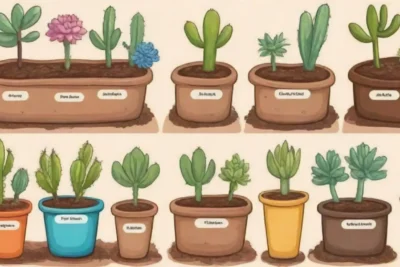
How to Choose the Right Tool for Succulent Replanting Tasks

Introduction
Succulents are a fascinating group of plants that have captured the hearts of many gardening enthusiasts. Their ability to store water and thrive in various environments makes them a popular choice for both indoor and outdoor spaces. However, like all plants, succulents occasionally need to be replanted to ensure their health and growth. Choosing the right tools for this process is essential, as it can greatly affect the success of your repotting efforts.
This article will guide you through the crucial factors to consider when selecting tools for succulent replanting. From understanding the unique needs of your succulents to identifying the right type of pots, soil, and accessories necessary for a seamless transition, this guide will provide you with everything you need to know for an optimal repotting experience. So, let’s dig in!
Understanding the Unique Needs of Succulents
When it comes to succulent care, it’s vital to recognize that these plants have unique characteristics and requirements. Unlike others, succulents thrive on neglect rather than excess care. Their water storage capabilities mean they are particularly sensitive to overwatering, which necessitates a tailored approach when transplanting. For instance, a well-draining soil mix specifically designed for cacti and succulents is paramount during replanting to prevent root rot and ensure adequate drainage.
In addition to choosing the right soil, it's essential to consider pot selection. A pot with drainage holes is a must for succulents, as it allows excess water to escape quickly. This prevents waterlogging, which is often the culprit behind the demise of many succulent plants. Additionally, the size of the pot should not exceed the root system; an overly large pot can retain too much moisture, leading to potential health issues for the succulent.
Lastly, the timing of repotting is just as crucial as the tools you use. Succulents are best replanted during their growing season, which typically occurs in spring and summer. During this time, succulents are more active and resilient, making them more receptive to changes in their environment and potting medium. Recognizing these specific needs will give you a solid foundation on which to base your tool-selection process.
Essential Tools for Replanting Succulents
As we delve deeper into the essentials of replanting succulents, it is important to recognize the critical tools that will aid in your replanting journey. Each tool has a specific purpose and can greatly enhance your ability to work effectively and efficiently.
1. Spade or Trowel
A spade or trowel is essential when it comes to digging out the succulent from its existing pot without damaging its roots. When selecting a spade or trowel, opt for a smaller, hand-held model for better control and precision. The tool should have a sharp edge for clean cuts through any roots that may have tangled or adhered to the pot, which can be quite common in pot-bound plants.
 Best Labeling Tools for Organizing Your Succulent Collection
Best Labeling Tools for Organizing Your Succulent CollectionWhen using the spade, carefully insert it around the plant’s edges to loosen the compacted soil and roots. Be gentle and move slowly, as succulents have delicate root systems that can easily snap. It’s advisable to work your way around the perimeter in a circular motion to ensure you have adequately released the plant from the confines of its pot.
2. Pruning Shears
Pruning shears are another vital tool in your succulent replanting kit. These scissors are designed with sharp, precise blades that allow for clean cuts without causing unnecessary harm to the plant. When repotting, you may encounter a situation where you need to trim away dead or rotting roots. Pruning shears enable you to remove these sections cleanly, thus promoting overall plant health.
Furthermore, pruning shears are useful for trimming any leggy or overly long growth on the succulent itself. This helps to encourage a more compact and healthy growth pattern, which is particularly desirable for species that can become tall or stretched out. Regularly using pruning shears when replanting can lead to vibrant, thriving succulents that maintain their charming appearance for years to come.
3. Soil Scoop
A soil scoop is not just a convenience but an essential tool for ensuring that the right amount of soil is placed around your succulent after repotting. Using a scoop helps to prevent spillage, allowing you to work neatly and maintain control over the soil distribution around the plant’s roots.
When using a soil scoop, choose one that is wide and has a long enough handle to allow for easy maneuverability. Begin by placing your succulent in the new pot, ensuring it's at the right depth, and then use the scoop to carefully add soil around the roots. This method minimizes the risk of damaging the delicate root system while also ensuring you achieve the appropriate soil-to-plant ratio for optimal growth.
Additional Accessories to Optimize the Replanting Process

Apart from the foundational tools mentioned above, there are also several accessories you might want to consider that can enhance your replanting experience.
 Understanding the Tools Needed for Succulent Landscape Design
Understanding the Tools Needed for Succulent Landscape Design1. Potting Mats
Using a potting mat can provide a clean workspace, making it easier to manage soil spills and excess debris during the replanting process. These mats are typically made of durable, water-resistant material that allows you to spread out your tools and soil without worrying about messes on your working surface.
Potting mats also help to gather clippings and soil that may fall during the process, allowing you to clean up with ease afterward. Choosing a potting mat that is easy to fold and store is a practical way to keep your gardening space organized and clutter-free.
2. Watering Can with a Narrow Spout
After replanting, it’s essential to give your succulent a gentle watering. A watering can with a narrow spout is ideal for this task as it allows you to control the water flow and direct it precisely at the base of the plant, minimizing the risk of water splashing onto the leaves. Excess moisture on a succulent's leaves can lead to rot, so careful watering is crucial during the initial transplant phase.
Make sure to choose a can that is comfortable to hold and has a spout long enough to reach into tight spaces. A durable watering can enhances your ability to provide your succulents with just the right amount of moisture needed to thrive without any detrimental effects.
3. Gloves for Protection
While it may not be immediately obvious, using gardening gloves can significantly enhance your replanting experience. Succulents sometimes have spines or sharp edges that can damage your skin, and gloves provide essential protection against these hazards. Choosing a pair that fits well and allows for good dexterity is crucial since you will need to work precisely when handling delicate succulents and digging in soil.
Additionally, gardening gloves can protect your hands from dirt and soilborne pathogens, keeping your hands clean while enhancing your comfort as you handle various soil components and tools.
Conclusion
Choosing the right tools for replanting succulents is a critical component in ensuring the long-term health and vitality of these resilient plants. By understanding their unique needs, selecting essential tools such as a spade, pruning shears, and a soil scoop, and considering accessories like a potting mat and an appropriately designed watering can, you can create an efficient and pleasant replanting experience.
 Cloning Your Succulents: Practical Tools for Propagation Success
Cloning Your Succulents: Practical Tools for Propagation SuccessMoreover, being attentive to details like the type of soil and pot you use, the time chosen for transplanting, and the proper watering techniques will further enhance your success in growing beautiful succulents. By investing time in learning about these aspects and equipping yourself with quality tools, you empower yourself to nurture your plants successfully.
Remember, gardening is as much about the process as it is about the outcome. Enjoy the journey of repotting your succulents, revel in the growth that follows, and take pride in the lush, vibrant plants that brighten your space. Happy gardening!
If you want to read more articles similar to How to Choose the Right Tool for Succulent Replanting Tasks, you can visit the Gardening Tools category.






You Must Read